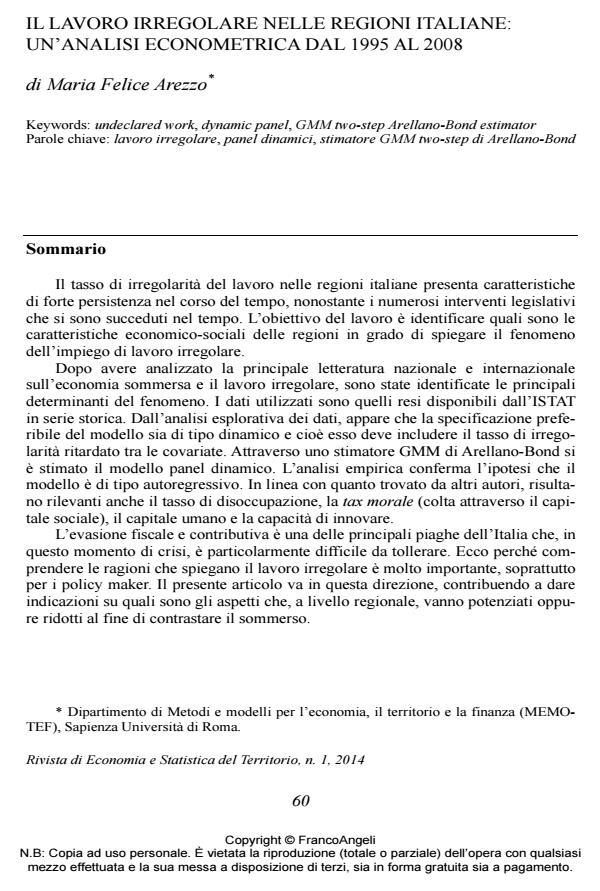Undeclared work in Italian regions: an econometric analysis in the time span 1995-2008
Journal title RIVISTA DI ECONOMIA E STATISTICA DEL TERRITORIO
Author/s Maria Felice Arezzo
Publishing Year 2014 Issue 2014/1
Language Italian Pages 18 P. 60-77 File size 994 KB
DOI 10.3280/REST2014-001003
DOI is like a bar code for intellectual property: to have more infomation
click here
Below, you can see the article first page
If you want to buy this article in PDF format, you can do it, following the instructions to buy download credits

FrancoAngeli is member of Publishers International Linking Association, Inc (PILA), a not-for-profit association which run the CrossRef service enabling links to and from online scholarly content.
Undeclared work rate in Italian regions has strong persistency features. It has remained constant or slightly increasing over decades, despites numerous laws aiming at reducing it. The aim of the paper is to identify the socio-economic characteristics that explain regional undeclared work rates.
Keywords: Undeclared work, dynamic panel, GMM two-step Arellano-Bond estimator
Jel codes: C01, C23, O17, J46
- Allingham M.G., Sandmo A. (1972), Income Tax Evasion: A Theorethical Analysis, Journal of Public Economics, 1, pp. 323-338.
- Boeri T., Garibaldi P. (2002), Shadow Activity and Unemployment in a Depressed Labour, Cepr Discussion Paper, 3433.
- Bovi M., Castellucci L. (2001), Cosa sappiamo dell’economia sommersa in Italia al di là dei luoghi comuni? Alcune proposizioni empiricamente fondate, Economia pubblica, 6: 78-119.
- Cappariello R., Zizza R. (2004), Economia sommersa e contesto istituzionale ed economico: un’analisi regionale, XIX National Conference of Labour Economics.
- Cenci M., Scarlato M. (2002), Settore sommerso e politiche di emersione: un approccio stocastico, Studi economici, 76, pp. 99-128.
- Cowell F. (1985), The Economic Analysis Of Tax Evasion, Bulletin of Economic Research, 37 (3), pp. 163-193.
- Frey B. (2003), Deterrence and Tax Morale in the European Union, European Review, 11 (3), pp. 163-193.
- Frey B. (2002), Deterrence and Morale in Taxation: An Empirical Analysis, CESifo Working Paper Series, 760.
- Hanifan L.J. (1916), The Rural School Community Centre, Annals of Amercian Academy of Political and Social Science.
- Jackson R., Milliron C. (1986), Tax Compliance Research: Findings, Problems and Prospect, Journal of Accounting Literature, 5, pp. 125-165.
- OCSE (2001), The Well-Being of Nations. The Role of Human and Social Capital, Paris: OECD
- Realfonzo R. (2007), Lavoro sommerso e modello di specializzazione produttiva: quali politiche? In: V. Pinto, Le politiche pubbliche di contrasto al lavoro irregolare. Bari: Cacucci.
- Sandmo A. (2004), The Theory of Tax Evasion: A Retrospective View, Discussion Paper.
- Santini I. (2008), Social Capital and its Impact on the Production Process, International Journal of Management Decision Making, 9 (5), pp. 509-525. Schneider F., Enste D.H. (2000), Shadow Economies: Size, Causes and Consequences, Journal of Economic Literature, 38, pp. 77-114.
- Schneider F., Williams C.C. (2013), Shadow Economy, London: The Institute of Economic Affairs.
- Sorcioni M. (2011), Il bastone e la carota, Newsletter Nuovi Lavori.
- World Bank (1998), The Infinitive on Defining, Monitoring and Measuring Social Capital. Text of Proposals approved for Funding Social Capital Iniziative, Working Paper 2.
- Yaniv G. (1999), Tax Evasion, Risky Laundering, and Optimal Deterrence Policy, International Tax and Public Finance, 6, pp. 27-38.
Maria Felice Arezzo, Il lavoro irregolare nelle regioni italiane: un’analisi econometrica dal 1995 al 2008 in "RIVISTA DI ECONOMIA E STATISTICA DEL TERRITORIO" 1/2014, pp 60-77, DOI: 10.3280/REST2014-001003